Chernyakhovsk
Chernyakhovsk (Russian: Черняхо́вск) – known prior to 1946 by its German name of ![]()
Chernyakhovsk Черняховск | |
|---|---|
Town[1] | |
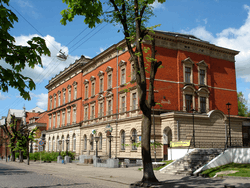 In Chernyakhovsk | |
.png) Flag .png) Coat of arms | |
Location of Chernyakhovsk 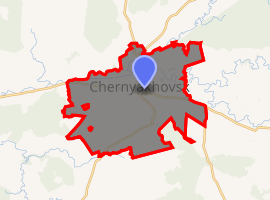
| |
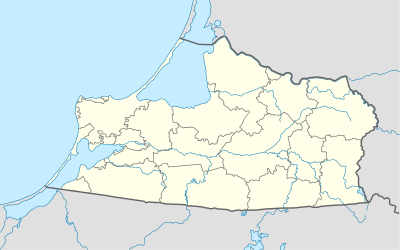 Chernyakhovsk Location of Chernyakhovsk .svg.png) Chernyakhovsk Chernyakhovsk (European Russia)  Chernyakhovsk Chernyakhovsk (Europe) | |
| Coordinates: 54°38′05″N 21°48′43″E | |
| Country | Russia |
| Federal subject | Kaliningrad Oblast[1] |
| Administrative district | Chernyakhovsky District[1] |
| Town of district significance | Chernyakhovsk[1] |
| Founded | 1337[2] |
| Town status since | 10 October 1583 |
| Area | |
| • Total | 58 km2 (22 sq mi) |
| Elevation | 30 m (100 ft) |
| Population | |
| • Estimate (2018)[3] | 35,888 |
| • Density | 628/km2 (1,630/sq mi) |
| • Capital of | Chernyakhovsky District[1], town of district significance of Chernyakhovsk[1] |
| • Municipal district | Chernyakhovsky Municipal District[4] |
| • Urban settlement | Chernyakhovskoye Urban Settlement[4] |
| • Capital of | Chernyakhovsky Municipal District[4], Chernyakhovskoye Urban Settlement[4] |
| Time zone | UTC+2 (MSK–1 |
| Postal code(s)[6] | 238150–238154, 238158, 238165, 238169, 238170, 238816 |
| Dialing code(s) | +7 40141 |
| OKTMO ID | 27739000001 |
| Website | inster39 |
History
Chernyakhovsk was founded in 1336 by the Teutonic Knights on the site of a former Old Prussian fortification when Dietrich von Altenburg, the Grand Master of the Teutonic Knights, built a castle called Insterburg following the Prussian Crusade.[2] During the Teutonic Knights' Northern Crusades campaign against the Grand Duchy of Lithuania, the town was devastated in 1376 and then again by Polish troops in 1457. The castle had been rebuilt as the seat of a Procurator and a settlement also named Insterburg grew up to serve it.
When the Prussian Duke Albert of Brandenburg-Ansbach in 1525 secularized the monastic State of the Teutonic Order, Insterburg became part of the Duchy of Prussia and was granted town privileges on 10 October 1583 by the Prussian regent Margrave George Frederick. Insterburg became part of the Kingdom of Prussia in 1701, and because the area had been depopulated by plague in the early 18th century, King Frederick William I of Prussia invited Protestant refugees who had been expelled from the Archbishopric of Salzburg to settle in Insterburg in 1732.
In 1818, after the Napoleonic Wars, the town became the seat of Insterburg District within the Gumbinnen Region. Michael Andreas Barclay de Tolly died at Insterburg in 1818 on his way from his Livonian manor to Germany, where he wanted to renew his health. In 1863, a Polish secret organization was founded and operated in Insterburg, which was involved in arms trafficking to the Russian Partition of Poland during the January Uprising. Since May 1864, the leader of the organization was Józef Racewicz.
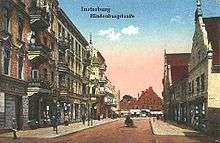
Insterburg became a part of the German Empire following the 1871 unification of Germany, and on May 1, 1901, it became an independent city separate from Insterburg District. During World War I the Russian Army seized Insterburg on 24 August 1914, but it was retaken by Germany on 11 September 1914. The Weimar Germany era after World War I saw the town separated from the rest of the country as the province of East Prussia had become an exclave. The association football club Yorck Boyen Insterburg was formed in 1921. During World War II, Insterburg was heavily bombed by the British Royal Air Force on July 27, 1944. The town was stormed by Red Army troops on January 21–22, 1945. As part of the northern part of East Prussia, Insterburg was transferred from Germany to the Soviet Union after the war as previously agreed between the victorious powers at the Potsdam Conference. The German population was either evacuated or expelled and replaced with Russians. On 7 April 1946, Insterburg was renamed as Chernyakhovsk in honor of the Soviet World War II Army General, Ivan Chernyakhovsky, who commanded the army that first entered East Prussia in 1944.[2]
After 1989, a group of people introduced the Akhal-Teke horse breed to the area and opened an Akhal-Teke breeding stable.
Administrative and municipal status
Within the framework of administrative divisions, Chernyakhovsk serves as the administrative center of Chernyakhovsky District.[1] As an administrative division, it is, together with five rural localities, incorporated within Chernyakhovsky District as the town of district significance of Chernyakhovsk.[1] As a municipal division, the town of district significance of Chernyakhovsk is incorporated within Chernyakhovsky Municipal District as Chernyakhovskoye Urban Settlement.[4]
Population trends
| Year | Number |
|---|---|
| 1790 | 4,972, without military[8] |
| 1875 | 16,303[9] |
| 1880 | 18,745[9] |
| 1885 | 22,227[9] |
| 1890 | 31,624, incl. 437 Catholics and 348 Jews[9] |
| 1900 | 27,787, incl. 788 Catholics and 350 Jews[10] |
| 1910 | 31,624, incl. 29,672 Protestants and 1,040 Catholics[9] |
| 1925 | 39,311, incl. 36,792 Protestants, 1,174 Catholics, 86 other Christians, and 338 Jews[9] |
| 1933 | 41,230, incl. 39,458 Protestants, 1,078 Catholics, five other Christians, and 273 Jews[9] |
| 1939 | 43,620, incl. 40,677 Protestants, 1,388 Catholics, 563 other Christians, and 87 Jews[9] |
| 1959 | approx. 29,100 |
| 1979 | approx. 35,600 |
| 1989 Census | 39,622[11] |
| 2002 Census | 44,323[12] |
| 2010 Census | 40,449[13] |
Military
Chernyakhovsk is home to the Chernyakhovsk naval air facility.
Coat of Arms Controversy
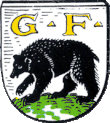
On September 2019 the local court ruled[14] that the coat of arms was illegal because it carries "elements of foreign culture." The local court alleged that Russian laws do not allow the use of foreign languages and symbols in Russian state symbols and ordered the town "to remove any violations of the law."
The town's coat of arms, adopted in 2002, was based on the historic coat of arms of the town that before 1946 was known under its original Prussian name - Insterburg.
The full version of coat of arms in question has a picture of a Prussian man with a horn and the Latin initials G.F. for the Regent of Prussia George Frederick, margrave of Brandenburg-Ansbach (1543–1603), who gave Insterburg the status of town and with it his family coat of arms.
The case brought before the court follows a trend among several towns in the region that have announced their intentions to change their coat of arms as tensions mount between Russia and the West following Moscow's annexation of Ukraine's Crimea in 2014 and its support for pro-Russian separatists in Ukraine's east.[14]
Notable people
- Martin Grünberg (1665-c.1706), architect
- Johann Friedrich Goldbeck (1748–1812), geographer and Protestant theologian
- Eduard Heinrich von Flottwell (1786–1865), politician
- Carl Friedrich Wilhelm Jordan (1819–1904), writer and politician
- Ernst Wichert (1831–1902), author
- Edward Frederick Moldenke (1836-1904) Lutheran theologian and missionary
- Hans Horst Meyer (1853–1939), pharmacologist
- Therese Malten (1855–1930), opera singer
- Paul Gerhard Neumann (1911-1986), physical oceanographer
- Hans Orlowski (1894-1967) woodcut artist and painter
- Hans Otto Erdmann (1896-1944), member of the German resistance to Nazism
- Fritz Karl Preikschat (1910-1994), engineer and inventor
- Kurt Kuhlmey (1913–1993), Bundeswehr major general
- Kurt Plenzat (1914–1998), military officer
- Traugott Buhre (1929–2009), actor
- Harry Boldt (born 1930), Olympic champion in dressage
- Anatol Herzfeld (1931–2019), German sculptor and mixed media artist
- Jürgen Schmude (born 1936), politician (SPD)
- Hans-Jürgen Quadbeck-Seeger (born 1939), chemist
- Anatole Klyosov (born 1946) a scientist in physical chemistry, enzyme catalysis and industrial biochemistry.
- Yuri Vasenin (born 1948) a retired Soviet football player and a current Russian coach.
Twin towns and sister cities
Chernyakhovsk is twinned with:





References
Notes
- Resolution #640
- Энциклопедия Города России. Moscow: Большая Российская Энциклопедия. 2003. p. 517. ISBN 5-7107-7399-9.
- "26. Численность постоянного населения Российской Федерации по муниципальным образованиям на 1 января 2018 года". Federal State Statistics Service. Retrieved January 23, 2019.
- Law #262
- "Об исчислении времени". Официальный интернет-портал правовой информации (in Russian). June 3, 2011. Retrieved January 19, 2019.
- Почта России. Информационно-вычислительный центр ОАСУ РПО. (Russian Post). Поиск объектов почтовой связи (Postal Objects Search) (in Russian)
- Kaemmerer, Margarete (2004). Ortsnamenverzeichnis der Ortschaften jenseits von Oder u. Neiße (in German). p. 65. ISBN 3-7921-0368-0.
- A. E. Henning: Topographisch-historische Beschreibung der Stadt Insterburg. Königsberg 1794, p. 44.
- Michael Rademacher: Deutsche Verwaltungsgeschichte Ostpreußen - Kreis Insterburg (2006)
- Meyers Koversations-Lexikon. 6. Auflage, Band 9, Leipzig und Wien 1908, p. 873.
- "Всесоюзная перепись населения 1989 г. Численность наличного населения союзных и автономных республик, автономных областей и округов, краёв, областей, районов, городских поселений и сёл-райцентров" [All Union Population Census of 1989: Present Population of Union and Autonomous Republics, Autonomous Oblasts and Okrugs, Krais, Oblasts, Districts, Urban Settlements, and Villages Serving as District Administrative Centers]. Всесоюзная перепись населения 1989 года [All-Union Population Census of 1989] (in Russian). Институт демографии Национального исследовательского университета: Высшая школа экономики [Institute of Demography at the National Research University: Higher School of Economics]. 1989 – via Demoscope Weekly.
- Russian Federal State Statistics Service (May 21, 2004). "Численность населения России, субъектов Российской Федерации в составе федеральных округов, районов, городских поселений, сельских населённых пунктов – районных центров и сельских населённых пунктов с населением 3 тысячи и более человек" [Population of Russia, Its Federal Districts, Federal Subjects, Districts, Urban Localities, Rural Localities—Administrative Centers, and Rural Localities with Population of Over 3,000] (XLS). Всероссийская перепись населения 2002 года [All-Russia Population Census of 2002] (in Russian).
- Russian Federal State Statistics Service (2011). "Всероссийская перепись населения 2010 года. Том 1" [2010 All-Russian Population Census, vol. 1]. Всероссийская перепись населения 2010 года [2010 All-Russia Population Census] (in Russian). Federal State Statistics Service.
- "Russian Court Finds Illegal 'German' Coat Of Arms Of Town In Far Western Exclave". RadioFreeEurope/RadioLiberty. Retrieved September 18, 2019.
Sources
- Правительство Калининградской области. Постановление №640 от 30 августа 2011 г. «Об утверждении реестра объектов административно-территориального деления Калининградской области», в ред. Постановления №877 от 21 ноября 2011 г «О внесении изменения в Постановление Правительства Калининградской области от 30 августа 2011 г. №640». Вступил в силу со дня официального опубликования. Опубликован: "Калининградская правда" (вкладыш "Официально"), №170, 15 сентября 2011 г. (Government of Kaliningrad Oblast. Resolution #640 of August 30, 2011 On the Adoption of the Registry of the Objects of the Administrative-Territorial Divisions of Kaliningrad Oblast, as amended by the Resolution #877 of November 21, 2011 On Amending the Resolution of the Government of Kaliningrad Oblast #640 of August 30, 2011. Effective as of the day of the official publication.).
- Калининградская областная Дума. Закон №262 от 30 июня 2008 г. «Об организации местного самоуправления на территории муниципального образования "Черняховский городской округ"», в ред. Закона №370 от 1 июля 2009 г «О составе территорий муниципальных образований Калининградской области». Вступил в силу со дня официального опубликования. Опубликован: "Калининградская правда", №124, 11 июля 2008 г. (Kaliningrad Oblast Duma. Law #262 of June 30, 2008 On the Organization of the Local Self-Government on the Territory of the Municipal Formation of "Chernyakhovsky Urban Okrug", as amended by the Law #370 of July 1, 2009 On the Composition of the Territories of the Municipal Formations of Kaliningrad Oblast. Effective as of the day of the official publication.).
External links
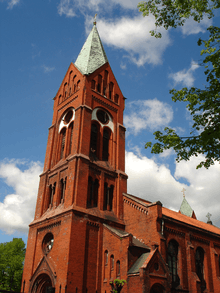
- Unofficial website of Chernyakhovsk (in Russian)
- Another unofficial website of Chernyakhovsk (in Russian)
- Pictures of Chernyakhovsk